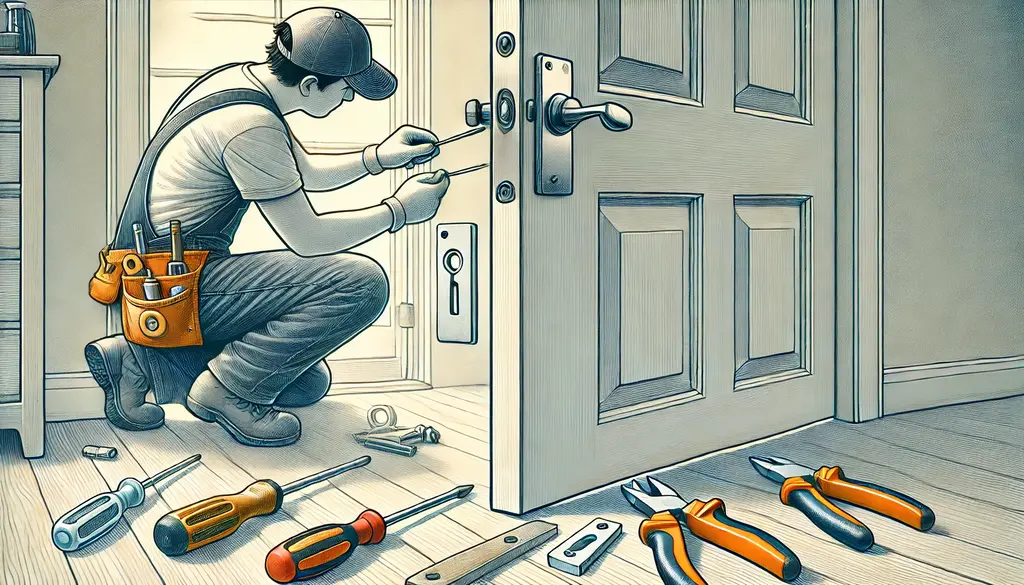Few household issues are as annoying as a door that refuses to latch properly. Whether it’s your bedroom door not providing the privacy you need, or an exterior door leaving your home vulnerable, a door that won’t latch is a problem that can’t be ignored.
Luckily, fixing this common issue is often easier than you might think. With the right knowledge, tools, and techniques, you can restore your door to perfect working conditions without needing to call in a professional.
In this comprehensive guide, we’ll walk you through everything you need to know about fixing a door that won’t latch. From diagnosing the problem to exploring a variety of effective solutions, this article is your one-stop resource for tackling this frustrating issue.
You may also like this: Garage Door Repair: Quick Fixes for Common Problems
Why Doors Won’t Latch?
A door that doesn’t latch properly can be caused by several factors, and understanding these causes is the first step toward fixing the issue. Here are the most common reasons:
- Misalignment Between Door and Frame: Over time, your house may settle or shift, causing the door and its frame to become misaligned. When this happens, the latch may no longer line up with the strike plate.
- Loose or Worn Hinges: Hinges that have loosened or worn down over time can cause the door to sag. Even a slight sag can prevent the latch from meeting the strike plate.
- Strike Plate Issues: The strike plate is the metal piece mounted on the door frame that catches the latch. If it’s installed improperly, bent, or damaged, it can prevent the latch from functioning as intended.
- Warped or Swollen Doors: Wood doors are susceptible to changes in temperature and humidity, which can cause them to warp or swell. This affects the alignment of the latch and the strike plate.
- Damaged Hardware: Over time, the latch mechanism or the strike plate can wear out or break, rendering them ineffective.
- Improper Installation: If a door was not installed correctly to begin with, latching issues can appear sooner rather than later.
By identifying the underlying cause of the issue, you’ll be able to select the most effective repair method.
Tools and Materials You Might Need
Before you get started on repairs, it’s a good idea to gather the tools and materials you’ll need. Here’s a list to ensure you’re well-prepared:
- Screwdriver (Phillips or flathead, depending on your door hardware)
- Hammer
- Chisel
- Drill and appropriate drill bits
- Wood filler
- Sandpaper
- Shims
- Metal file
- Replacement screws
- Replacement latch or strike plate (if needed)
- Pencil or marker for marking adjustments
Having all these tools ready will help you work efficiently and avoid interruptions.
Step-by-Step Guide to Fixing a Door That Won’t Latch
Now that you understand the potential causes and have your tools ready, let’s dive into the solutions. Follow these steps carefully to address the specific issue affecting your door.
Step 1: Tighten Loose Hinges
The first step is to check whether loose hinges are causing the problem. Open the door and inspect the hinges closely. If you notice any loose screws, use a screwdriver to tighten them.
In some cases, the screws might be stripped, making them unable to grip the wood properly. To fix this, remove the stripped screws and fill the holes with wood filler or glue-coated toothpicks. Once the filler or glue has dried, reinsert the screws and tighten them securely. Alternatively, you can use longer screws to reach deeper into the door frame for a stronger hold.
Step 2: Adjust the Strike Plate
If tightening the hinges doesn’t resolve the issue, the problem may lie with the strike plate. Open and close the door slowly to observe how the latch interacts with the strike plate. If the latch isn’t aligning properly, you’ll need to adjust the strike plate.
Loosen the screws holding the strike plate in place. Gently tap the plate up, down, or sideways with a hammer to reposition it so the latch aligns correctly. Retighten the screws once you’ve achieved proper alignment.
If minor adjustments don’t solve the issue, you may need to remove the strike plate entirely and reposition it. Use a chisel to create a new recess in the door frame for the strike plate, ensuring it sits flush with the frame. Fill the old recess with wood filler and sand it smooth once it dries.
Step 3: Enlarge the Strike Plate Hole
If the latch is hitting the strike plate but not fully entering the hole, you’ll need to enlarge the hole slightly. Use a metal file or rotary tool to carefully widen the opening in the strike plate. Test the door frequently during this process to ensure you don’t overdo it.
Step 4: Shim the Hinges
If the door is sagging slightly, adding shims to the hinges can correct its alignment. Start by removing the screws from the hinges and gently prying the hinge away from the door or frame. Insert a thin shim (made of cardboard or plastic) behind the hinge leaf. Reattach the hinge and tighten the screws. Repeat this process for all hinges if necessary.
Shimming may require some trial and error to achieve the perfect alignment, but it’s a simple and effective fix for many door latching problems.
Step 5: Replace Damaged Hardware
If the latch mechanism or strike plate is damaged beyond repair, replacing these components is your best option. Most hardware stores carry universal replacement parts. Remove the old latch or strike plate and install the new ones according to the manufacturer’s instructions. Ensure all screws are tightened securely.
Step 6: Address Warped or Swollen Doors
If your door has swollen or warped due to humidity, you may need to sand down the edges to restore proper clearance. Use coarse-grit sandpaper to remove material gradually, checking frequently to avoid over-sanding. For severe warping, a planer may be necessary, or you might consider replacing the door entirely.
To prevent future swelling, control the humidity levels in your home with a dehumidifier or air conditioner.
Preventative Measures to Avoid Future Problems
To keep your doors functioning smoothly and avoid recurring latching issues, consider adopting these preventative measures:
- Perform Regular Maintenance: Periodically check your door hardware for signs of wear and tear. Tighten loose screws and lubricate moving parts as needed.
- Control Indoor Humidity: Maintaining a consistent indoor environment can prevent doors from swelling or warping. Use a dehumidifier or air conditioning to keep humidity levels in check.
- Install Doors Properly: If installing a new door, ensure it’s done correctly. Misaligned doors are prone to latching problems.
- Upgrade Hardware: Invest in high-quality hardware to reduce the likelihood of wear and tear.
When to Seek Professional Help?
If your door’s latching issues persist despite your best efforts, it may be time to call in a professional. Complex problems, such as severely misaligned frames or structural damage, require specialized tools and expertise. Additionally, if you’re dealing with antique or custom doors, a professional can ensure they are handled with care.
Conclusion
A door that won’t latch is more than just a nuisance—it’s a problem that can affect your privacy, security, and peace of mind. Fortunately, fixing this issue is often straightforward and achievable with basic tools and a little know-how. From tightening loose hinges to repositioning strike plates and replacing worn-out hardware, the solutions are varied and effective.
By following the steps outlined in this guide, you can restore your door to proper working order and enjoy the satisfaction of a job well done. And with regular maintenance and preventative measures, you can ensure your doors continue to latch securely for years to come.

